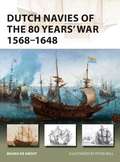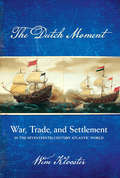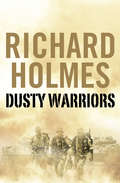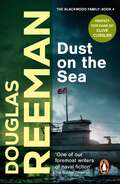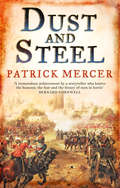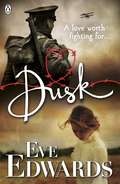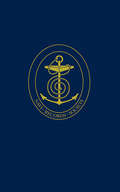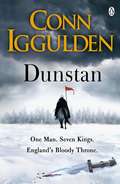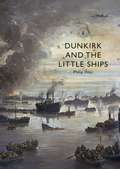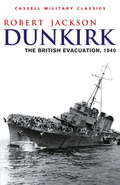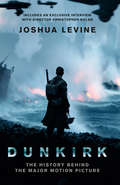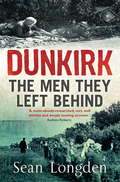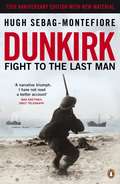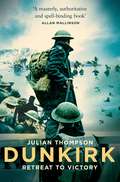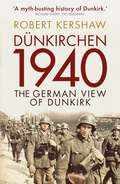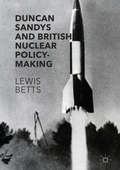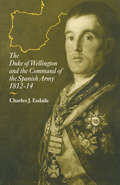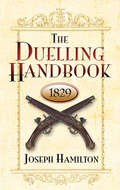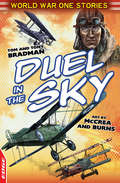- Table View
- List View
Dutch Navies of the 80 Years' War 1568–1648 (New Vanguard)
by Peter Bull Bouko De GrootThe tiny new state of the United Provinces of the Netherlands won its independence from the mighty Spanish empire by fighting and winning the Eighty Years' War, from 1568 and 1648. In this long conflict, warfare on water played a much bigger role in determining the ultimate victor. On the high seas the fleet carved out a new empire, growing national income to such levels that it could continue the costly war for independence. Yet it was in coastal and inland waters that the most decisive battles were fought. Arguably the most decisive Spanish siege (Leiden, 1574) was broken by a fleet sailing to the rescue across flooded polders, and the battle of Nieuwpoort in 1600, the largest successful invasion fleet before World War II, was one of the most decisive battle in western history. Using detailed full colour artwork, this book shows how the Dutch navies fought worldwide in their war of independence, from Brazil to Indonesia, and from the Low Countries to Angola.
The Dutch Moment: War, Trade, and Settlement in the Seventeenth-Century Atlantic World
by Wim KloosterIn The Dutch Moment, Wim Klooster shows how the Dutch built and eventually lost an Atlantic empire that stretched from the homeland in the United Provinces to the Hudson River and from Brazil and the Caribbean to the African Gold Coast. The fleets and armies that fought for the Dutch in the decades-long war against Spain included numerous foreigners, largely drawn from countries in northwestern Europe. Likewise, many settlers of Dutch colonies were born in other parts of Europe or the New World. The Dutch would not have been able to achieve military victories without the native alliances they carefully cultivated. Indeed, the Dutch Atlantic was quintessentially interimperial, multinational, and multiracial. At the same time, it was an empire entirely designed to benefit the United Provinces. The pivotal colony in the Dutch Atlantic was Brazil, half of which was conquered by the Dutch West India Company. Its brief lifespan notwithstanding, Dutch Brazil (1630–1654) had a lasting impact on the Atlantic world. The scope of Dutch warfare in Brazil is hard to overestimate—this was the largest interimperial conflict of the seventeenth-century Atlantic. Brazil launched the Dutch into the transatlantic slave trade, a business they soon dominated. At the same time, Dutch Brazil paved the way for a Jewish life in freedom in the Americas after the first American synagogues opened their doors in Recife. In the end, the entire colony eventually reverted to Portuguese rule, in part because Dutch soldiers, plagued by perennial poverty, famine, and misery, refused to take up arms. As they did elsewhere, the Dutch lost a crucial colony because of the empire’s systematic neglect of the very soldiers on whom its defenses rested.After the loss of Brazil and, ten years later, New Netherland, the Dutch scaled back their political ambitions in the Atlantic world. Their American colonies barely survived wars with England and France. As the imperial dimension waned, the interimperial dimension gained strength. Dutch commerce with residents of foreign empires thrived in a process of constant adaptation to foreign settlers’ needs and mercantilist obstacles.
Dusty Warriors (Text Only): Modern Soldiers At War (text Only)
by Richard HolmesForemost military historian Richard Holmes offers us a compelling and at times terrifying account of what it means to be a contemporary soldier.
The Dust that Falls from Dreams
by Louis De BernieresA return to the epic romance, heroism, history and warm and eccentric cast of characters that made CAPTAIN CORELLI'S MANDOLIN such an extraordinary hit (2.5 million copies sold).In the brief golden years before the outbreak of World War I, Rosie McCosh and her three very different sisters are growing up in an eccentric household in Kent, with their neighbours the Pitt boys on one side and the Pendennis boys on the other. But their days of childhood adventure are shadowed by the approach of the conflict that will engulf them on the cusp of adulthood.When the boys end up scattered along the Western Front, Rosie is left confused by her love for two young men - one an infantry soldier and one a flying ace. Can she, and her sisters, build new lives out of the opportunities and devastations that follow the Great War?
Dust On The Sea: an all-action, edge-of-your-seat naval adventure from the master storyteller of the sea (The\royal Marines Ser. #4)
by Douglas ReemanIt is 1943, and Captain Mike Blackwood, Royal Marine Commando, is a survivor. Young, toughened and tried in the hellish crucible of Burma, he labours, sometimes faltering, beneath the weight of tradition, the glorious heritage of his family, and the burden of his own self-doubt. For Blackwood, the horizon is not the lip of the trench seen by men of the Corps in the previous war, but the ramp of a landing craft smashing down into the sea, and the fire of the enemy on a Sicilian beach. Here, tradition is not enough, and Mike Blackwood must find within himself qualities of leadership which will inspire those Royal Marines who are once again the first to land, and among the first to die. This is the fourth novel in the Blackwood saga, spanning 150 years in the history of a great seafaring family and the tradition in which they served.
Dust Clouds of War (Simon Fonthill #12)
by John WilcoxSeptember, 1914. The First World War has already broken out on the Western Front. Thousands of miles away, on the border between Northern Rhodesia and German East Africa, Simon Fonthill is preparing for battle alongside his faithful companion ‘352’ Jenkins and his reliable tracker, Mzingeli.As they negotiate their way across foreign lands and hostile territories, the Magnificent Trio come under constant fire from enemy forces and at the bequest of Admiral Herbert King-Hall, they undertake their most dangerous mission yet. Sinking the Königsberg, a German cruiser ship hidden deep in the Rufiji Delta in German occupied waters, will test the trio’s nerve, courage and determination to the limit.Meanwhile, Fonthill’s wife Alice has been conducting investigations of her own in Mombasa – and when she thinks something is amiss within the camp, she takes matters into her own hands. Amidst the chaos of war, treachery is never far away . . .
Dust and Steel
by Patrick MercerThrilling military history from the author of To Do and Die. Perfect for fans of Andy McNabb and Richard Sharpe.
Dusk
by Eve EdwardsDusk by Eve Edwards is a beautiful love story set against the brutal back drop of WWI.For all fans of Sebastian Faulks and historical fiction - this is Bird Song for young adult readers.A love worth fighting for.When Helen, a young hard-working nurse, meets aristocratic artist Sebastian, she doesn't expect to even like him, let alone fall in love. But against the troubled backdrop of wartime London, an unlikely but intense romance blossoms. And even the bloody trenches of the Somme, where they are both posted, cannot diminish their feelings for each other.But Helen is concealing a secret and when a terrible crime is committed there are devastating consequences for them both.When lives are being lost, can true love survive?Eve Edwards is an award-winning author. She lives in Oxford and is married with three children.www.eve-edwards.com
The Durham Papers: Selections from the Papers of Admiral Sir Philip Charles Henderson Calderwood Durham G.C.B. (1763-1845) (Navy Records Society Publications)
by Hilary L. RubinsteinAdmiral Sir Philip Durham (1763–1845) was one of the most distinguished and colourful officers of the late Georgian Navy. His lucky and sometimes controversial career included surviving the sinking of HMS Royal George in 1782, making the first conquest of the tricolour flag in 1793 and the last in 1815, and having two enemy ships surrender to him at Trafalgar. A Scot distantly related to Lord Barham, Durham entered the Navy in 1777, serving initially on the American and West Indies stations. He was Kempenfelt's signal officer on HMS Victory during the second battle of Ushant in 1781 and on the Royal George. Making his reputation initially as the daring young master and commander of HMS Spitfire early in the French Revolutionary War, he became a crack frigate captain with a fortune in prize money, and commanded HMS Defiance at Trafalgar, where he was wounded. He ended his war service as Commander-in-Chief, Leeward Islands. En voyage he artfully captured two brand-new French frigates which were subsequently taken into the service of Britain, and during his tenure he won the heartfelt gratitude of local merchants by ridding the surrounding seas of American privateers preying on British trading vessels. True to form, he clashed with the judge of the Vice-Admiralty Court on Antigua and with the general with whom he led a combined naval and military assault on Martinique and Guadeloupe following Napoleon's escape from Elba. He later served as Commander-in-Chief, Portsmouth having resigned his parliamentary seat to do so. Married first to the sister of the Earl of Elgin, of 'Marbles' fame, and secondly to a cousin of 'sea wolf' Lord Cochrane, he was well-known to George III, who as a result of Durham's amusing yet improbable anecdotes, dubbed any tall tale he heard 'a Durham'. This collection of his papers consists mainly of letters and despatches relating to his service in the Channel Fleet, the Mediterranean, and the Leeward Islands. Correspondence with his parents during 1789–1790 reflects his anxieties relating to employment and prospects for promotion when he was a young lieutenant with an illegitimate child to support. The collection, featuring items from and to him, comprises a fascinating and informative set of documents.
The Durham Papers: Selections from the Papers of Admiral Sir Philip Charles Henderson Calderwood Durham G.C.B. (1763-1845) (Navy Records Society Publications #166)
by Hilary L. RubinsteinAdmiral Sir Philip Durham (1763–1845) was one of the most distinguished and colourful officers of the late Georgian Navy. His lucky and sometimes controversial career included surviving the sinking of HMS Royal George in 1782, making the first conquest of the tricolour flag in 1793 and the last in 1815, and having two enemy ships surrender to him at Trafalgar. A Scot distantly related to Lord Barham, Durham entered the Navy in 1777, serving initially on the American and West Indies stations. He was Kempenfelt's signal officer on HMS Victory during the second battle of Ushant in 1781 and on the Royal George. Making his reputation initially as the daring young master and commander of HMS Spitfire early in the French Revolutionary War, he became a crack frigate captain with a fortune in prize money, and commanded HMS Defiance at Trafalgar, where he was wounded. He ended his war service as Commander-in-Chief, Leeward Islands. En voyage he artfully captured two brand-new French frigates which were subsequently taken into the service of Britain, and during his tenure he won the heartfelt gratitude of local merchants by ridding the surrounding seas of American privateers preying on British trading vessels. True to form, he clashed with the judge of the Vice-Admiralty Court on Antigua and with the general with whom he led a combined naval and military assault on Martinique and Guadeloupe following Napoleon's escape from Elba. He later served as Commander-in-Chief, Portsmouth having resigned his parliamentary seat to do so. Married first to the sister of the Earl of Elgin, of 'Marbles' fame, and secondly to a cousin of 'sea wolf' Lord Cochrane, he was well-known to George III, who as a result of Durham's amusing yet improbable anecdotes, dubbed any tall tale he heard 'a Durham'. This collection of his papers consists mainly of letters and despatches relating to his service in the Channel Fleet, the Mediterranean, and the Leeward Islands. Correspondence with his parents during 1789–1790 reflects his anxieties relating to employment and prospects for promotion when he was a young lieutenant with an illegitimate child to support. The collection, featuring items from and to him, comprises a fascinating and informative set of documents.
Dunstan: One Man. Seven Kings. England's Bloody Throne.
by Conn IgguldenOne man. Seven Kings. England's bloody throne. 'Iggulden tells an absolutely cracking story. The pace is nail-biting and the set dressing magnificent' The TimesTenth century England: a divided and broken country of misrule. Yet King Athelstan, grandson of Alfred the Great, seeks to unite the kingdom under one crown. By his side is Dunstan of Glastonbury - priest, soldier, visionary and, some insist, traitor - whose task is to steward seven kings through fire, war, murder and fury to see Athelstan's dream come true. But what stain will it leave on his mortal soul?'Iggulden has created an intriguingly complex saint - flawed, spiteful and unreliable as the teller of his own tale. Through his eyes we watch the story of the making of England' The Times'Engrossing. Rich in intrigue, with Iggulden breathing life into this remarkable and complex figure who played a vital role in safeguarding a newly united England' Daily Express'A gripping and glorious legend. Brilliant!' Weekend Sport'Breathes new life into the darkest and most dramatic of times' Star'Dunstan is a vivid, convincing character' BBC History Magazine
Dunkirk and the Little Ships (Shire Library #867)
by Philip WeirIn May 1940, German troops advanced through Holland, Belgium and France with astonishing speed, forcing the British Expeditionary Force and the French army to retreat to the north-east coast of France. The evacuation plan – Operation Dynamo – was put into effect with the expectation that only about 45,000 men might be rescued. However, by the hasty assembly of a vast armada of disparate vessels (thought to be in the region of 900, of which about 700 were privately owned), 338,226 Allied troops were brought safely back to England. Without the contribution of those Dunkirk Little Ships, as they have come to be known, thousands of British troops would have died on the shores of France, and the ongoing fight against the Axis powers rendered all the more challenging. In this title, Philip Weir reveals the story of all the vessels that undertook such a great mission, exploring their general role and individual histories, including their preservation and the Little Ships participation in return runs every five years.
Dunkirk and the Little Ships (Shire Library)
by Philip WeirIn May 1940, German troops advanced through Holland, Belgium and France with astonishing speed, forcing the British Expeditionary Force and the French army to retreat to the north-east coast of France. The evacuation plan – Operation Dynamo – was put into effect with the expectation that only about 45,000 men might be rescued. However, by the hasty assembly of a vast armada of disparate vessels (thought to be in the region of 900, of which about 700 were privately owned), 338,226 Allied troops were brought safely back to England. Without the contribution of those Dunkirk Little Ships, as they have come to be known, thousands of British troops would have died on the shores of France, and the ongoing fight against the Axis powers rendered all the more challenging. In this title, Philip Weir reveals the story of all the vessels that undertook such a great mission, exploring their general role and individual histories, including their preservation and the Little Ships participation in return runs every five years.
Dunkirk
by A.D. Divine O.B.E.This is the story of Dunkirk and of the men who planned it (insofar as it was planned) and of the men who carried it out, and of their ships. Mr Divine, who was himself with the small boats, writes with the authority of direct knowledge. He had the assistance of the men who were intimately concerned with planning and organising the operation. This is the true story of Dunkirk from its almost nebulous beginnings to the astonishing triumph of its end.
Dunkirk: The British Evacuation, 1940 (Sven Hassel War Classics)
by Robert JacksonA gripping account of the most famous military defeat and retreat in history, now the subject of a major motion picture, written and directed by Christopher Nolan and starring Kenneth Branagh, Tom Hardy and Mark Rylance.The NEW YORK TIMES of 2 June 1940 summed up the greatest disaster in British history thus: 'As long as the English tongue survives, the word 'Dunkirk' will be spoken with reverence.'This book tells the story of the Dunkirk evacuation. It traces the fortunes of the British Expeditionary Force during those dark days of May 1940 when boys armed with little more than rifles took on the might of Hitler's Panzer divisions - and held them while Allied armies crumbled on all sides. The evacuation at Dunkirk lifted more than 338,000 men from France to the safety of Britain using everything from Destroyers to pleasure yachts. It was the biggest single defeat ever suffered by British arms, but it was also one of the most astounding exoduses in history.
Dunkirk: The History Behind The Major Motion Picture
by Joshua LevineTHE NUMBER ONE SUNDAY TIMES BESTSELLER THE EPIC TRUE STORY OF DUNKIRK – NOW A MAJOR MOTION PICTURE, WRITTEN AND DIRECTED BY CHRISTOPHER NOLAN AND STARRING KENNETH BRANAGH, TOM HARDY AND MARK RYLANCE.
Dunkirk: The Men They Left Behind
by Sean LongdenTHE TRUE STORY OF THE 41,000 BRITISH SOLDIERS WHO WERE LEFT BEHIND AFTER THE EVACUATION OF DUNKIRK, MAY 1940'Meticulously researched, very well written and deeply moving' Andrew Roberts'Few readers will be unmoved by Sean Longden's account' Dominic SandbrookAt 2am on the morning of the 3rd of June 1940, General Harold Alexander searched along the quayside, holding onto his megaphone and called "Is anyone there? Is anyone there?" before turning his boat back towards England. Tradition tells us that the dramatic events of the evacuation of Dunkirk, in which 300,000 BEF servicemen escaped the Nazis, was a victory gained from the jaws of defeat. For the first time, rather than telling the tale of the 300,000 who escaped, Sean Longden reveals the story of the 40,000 men sacrificed in the rearguard battles.On the beaches and sand dunes, besides the roads and amidst the ruins lay the corpses of hundreds who had not reached the boats. Elsewhere, hospitals full of the sick and wounded who had been left behind to receive treatment from the enemy's doctors. And further afield - still fighting hard alongside their French allies - was the entire 51st Highland Division, whose war had not finished as the last boats slipped away. Also scattered across the countryside were hundreds of lost and lonely soldiers. These 'evaders' had also missed the boats and were now desperately trying to make their own way home, either by walking across France or rowing across the channel. The majority, however, were now prisoners of war who were forced to walk on the death marches all the way to the camps in Germany and Poland, where they were forgotten until 1945.'Sean Longden is a rising name in military history, and is able to uncover the missing stories of the Second World War' Guardian
Dunkirk: Fight to the Last Man
by Hugh Sebag-Montefiore* * * Special 75th Anniversary Edition * * * Hugh Sebag-Montefiore's Dunkirk: Fight to the Last Man tells the story of the rescue in May 1940 of British soldiers fleeing capture and defeat by the Nazis at Dunkirk.Dunkirk was not just about what happened at sea and on the beaches. The evacuation would never have succeeded had it not been for the tenacity of the British soldiers who stayed behind to ensure they got away. Men like Sergeant Major Gus Jennings who died smothering a German stick bomb in the church at Esquelbecq in an effort to save his comrades, and Captain Marcus Ervine-Andrews VC who single-handedly held back a German attack on the Dunkirk perimeter thereby allowing the British line to form up behind him. Told to stand and fight to the last man, these brave few battalions fought in whatever manner they could to buy precious time for the evacuation. Outnumbered and outgunned, they launched spectacular and heroic attacks time and again, despite ferocious fighting and the knowledge that for many only capture or death would end their struggle.'A searing story . . . both meticulous military history and a deeply moving testimony to the extraordinary personal bravery of individual soldiers' Tim Gardam, The Times 'Sebag-Montefiore tells [the story] with gusto, a remarkable attention to detail and an inexhaustible appetite for tracking down the evidence' Richard Ovary, Telegraph Hugh Sebag-Montefiore was a barrister before becoming a journalist and then an author. He wrote the best-selling Enigma: The Battle for the Code. One of his ancestors was evacuated from Dunkirk.
Dunkirk: Retreat to Victory
by Julian ThompsonA masterly work of military history, Dunkirk: Retreat to Victory is also a tribute to the soldiers whose courage and self belief sustained them through their darkest hours.The evacuation of British forces from Dunkirk is one of the pivotal moments in the Second World War – an astonishing endeavour that snatched victory from the jaws of defeat. Sent to help the Belgians and French hold back the German army, the small British Expeditionary Force was ill-equipped and under-trained. When Hitler attacked on 10 May 1940 and the French and Belgian armies collapsed in the face of Germany's swift and brutal advance, the British soldiers found themselves in mortal danger.In Dunkirk: Retreat to Victory, Major General Julian Thompson recreates the action as the British fought hard for three desperate weeks, conducting a successful fighting withdrawal in the face of a formidable foe. He describes the individual acts of bravery and sacrifice and analyses the decisions of the commanders who made the choice to evacuate. He also takes us to Dunkirk harbour and onto the beaches, where the British army was trapped and under attack, while the Royal Navy and the 'little ships' raced against time to rescue them.
Dünkirchen 1940: The German View of Dunkirk
by Robert KershawUsing revelatory new material on an event which changed the tide of World War II, Robert Kershaw's ground-breaking history explores the Battle of Dunkirk from the German perspective.'Military history of the highest order.' Jonathan Dimbleby, author and broadcaster The British evacuation from the beaches of the small French port town of Dunkirk is one of the iconic moments of military history. The battle has captured the popular imagination through LIFE magazine photo spreads, the fiction of Ian McEwan and, of course, Christopher Nolan's hugely successful Hollywood blockbuster. But what is the German view of this stunning Allied escape? Drawing on German interviews, diaries and unit post-action reports, Robert Kershaw creates a page-turning history of a battle that we thought we knew. Dünkirchen 1940 is the first major history on what went wrong for the Germans at Dunkirk. As supreme military commander, Hitler had seemingly achieved a miracle after the swift capitulation of Holland and Belgium, but with just seven kilometres before the panzers captured Dunkirk – the only port through which the trapped British Expeditionary force might escape – they came to a shuddering stop. Hitler had lost control of his stunning advance. Only a detailed interpretation of the German perspective – historically lacking to date – can provide answers as to why. Drawing on his own military experience, his German language skills and his historian's eye for detail, Robert Kershaw creates a new history of this familiar battle. With a fresh angle on this famous conflict, Dünkirchen 1940 delves into the under-evaluated major German miscalculation both strategically and tactically that arguably cost Hitler the war.
Dünkirchen 1940: The German View of Dunkirk
by Robert KershawUsing revelatory new material on an event which changed the tide of World War II, Robert Kershaw's ground-breaking history explores the Battle of Dunkirk from the German perspective.'Military history of the highest order.' Jonathan Dimbleby, author and broadcaster The British evacuation from the beaches of the small French port town of Dunkirk is one of the iconic moments of military history. The battle has captured the popular imagination through LIFE magazine photo spreads, the fiction of Ian McEwan and, of course, Christopher Nolan's hugely successful Hollywood blockbuster. But what is the German view of this stunning Allied escape? Drawing on German interviews, diaries and unit post-action reports, Robert Kershaw creates a page-turning history of a battle that we thought we knew. Dünkirchen 1940 is the first major history on what went wrong for the Germans at Dunkirk. As supreme military commander, Hitler had seemingly achieved a miracle after the swift capitulation of Holland and Belgium, but with just seven kilometres before the panzers captured Dunkirk – the only port through which the trapped British Expeditionary force might escape – they came to a shuddering stop. Hitler had lost control of his stunning advance. Only a detailed interpretation of the German perspective – historically lacking to date – can provide answers as to why. Drawing on his own military experience, his German language skills and his historian's eye for detail, Robert Kershaw creates a new history of this familiar battle. With a fresh angle on this famous conflict, Dünkirchen 1940 delves into the under-evaluated major German miscalculation both strategically and tactically that arguably cost Hitler the war.
Duncan Sandys and British Nuclear Policy-Making
by Lewis BettsThis book offers new perspectives on British nuclear policy-making at the height of the Cold War, arguing that the decisions taken by the British government during the 1950s and 1960s in pursuit of its nuclear ambitions cannot be properly understood without close reference to Duncan Sandys, and in particular the policy preferences that emerged from his experiences of the Second World War and his efforts leading Britain's campaign against the V-1 and V-2. Immersing himself in this campaign against unmanned weaponry, Sandys came to see ballistic missiles as the only guarantor of nuclear credibility in the post-war world, placing them at the centre of his strategic thinking and developing a sincerely-held and logically-consistent belief system which he carried with him through a succession of ministerial roles, allowing him to exert a previously undocumented level of influence on the nature of Britain's nuclear capabilities and its approach to the Cold War. This book shows the profound influence Sandys' personal belief system had on Britain's attempts to acquire a credible nuclear deterrent.
The Duelling Handbook, 1829
by Joseph HamiltonProfoundly embedded in our cultural consciousness, the art of duelling evokes images of a dramatic past, where the laws of courtesy, civility, and honor were enforced by the end of a rapier at the first rays of dawn. In this engrossing historical record of the codes and conduct of the duel — originally written in 1829 as "The Only Approved Guide Through All the Stages of a Quarrel" — every aspect of the arcane practice is brought to fascinating light.Offering authentic advice on such subjects as withdrawal of challenges, weapons, distance, and the fate of survivors, The Duelling Handbook also brims with vivid anecdotes recounting duels between brothers, duels between friends, and those arising from disagreements over religion, women, gambling, and other volatile standpoints. A genuine historical treasure, Hamilton's unequaled guidebook will captivate — and enlighten — a wide audience of readers, especially those intrigued by the moral and sociological issues surrounding the art of the duel.
Duel In The Sky: World War One Short Stories: Duel In The Sky (EDGE: World War One Short Stories #1)
by Tony BradmanA new German fighter ace is terrorising British planes over the trenches of France. It will take the bravery and sacrifice of a Britsh ace and the courage of a hero to bring him down.This title is published by Franklin Watts EDGE, which produces a range of books to get children reading with confidence. EDGE - for books kids can't put down.
